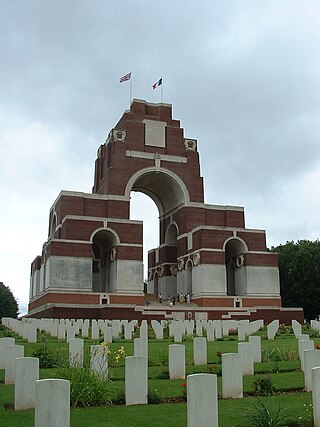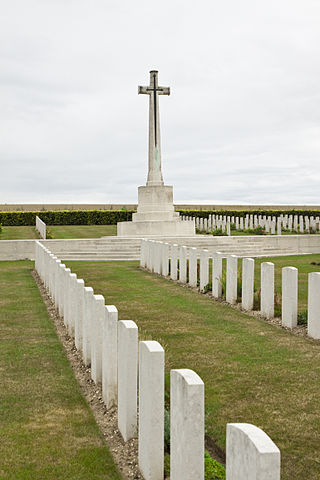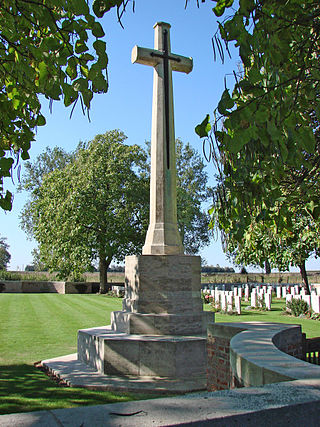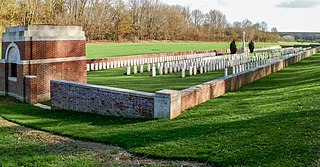
The Thiepval Memorial to the Missing of the Somme is a war memorial to 72,337 missing British and South African servicemen who died in the Battles of the Somme of the First World War between 1915 and 1918, with no known grave. It is near the village of Thiepval, Picardy in France. A visitors' centre opened in 2004. Designed by Sir Edwin Lutyens, Thiepval has been described as "the greatest executed British work of monumental architecture of the twentieth century".

The Cross of Sacrifice is a Commonwealth war memorial designed in 1918 by Sir Reginald Blomfield for the Imperial War Graves Commission. It is present in Commonwealth war cemeteries containing 40 or more graves. Its shape is an elongated Latin cross with proportions more typical of the Celtic cross, with the shaft and crossarm octagonal in section. It ranges in height from 18 to 24 feet. A bronze longsword, blade down, is affixed to the front of the cross. It is usually mounted on an octagonal base. It may be freestanding or incorporated into other cemetery features. The Cross of Sacrifice is widely praised, widely imitated, and the archetypal British war memorial. It is the most imitated of Commonwealth war memorials, and duplicates and imitations have been used around the world.

Railway Dugouts Burial Ground (Transport Farm) is a Commonwealth War Graves Commission (CWGC) burial ground for the dead of the First World War located in the Ypres Salient on the Western Front.
Adanac Military Cemetery is a Commonwealth War Graves Commission burial ground for the dead of World War I located near the French villages of Miraumont, Pys and Courcelette and contains 3,187 interments, 1483 of whom are identified.

The Pozières Memorial is a World War I memorial, located near the commune of Pozières, in the Somme department of France, and unveiled in August 1930. It lists the names of 14,657 British and South African soldiers of the Fifth and Fourth Armies with no known grave who were killed between 21 March 1918 and 7 August 1918, during the German advance known as the Spring Offensive, and the period of Allied consolidation and recovery that followed. The final date is determined by the start of the period known as the Advance to Victory on 8 August.
Rocquigny-Equancourt Road British Cemetery is a war grave for mainly Commonwealth soldiers who died in the First World War. It was designed by Sir Reginald Blomfield in the 1920s and contains the bodies of 2,046 people: 1,817 identified Commonwealth casualties plus 21 unidentified casualties; also 198 German casualties and 10 French civilians.
The Bapaume Communal Cemetery is a cemetery located in the French commune of Bapaume (Pas-de-Calais). It is in part a military cemetery, one of several in the area maintained by the Commonwealth War Graves Commission. The CWGC graves are in small plots scattered in different parts of the cemetery and commemorate British and Commonwealth soldiers who fought in World War I and World War II.

Caterpillar Valley Cemetery is a World War I Commonwealth War Graves Commission cemetery in Longueval, France.

AIF Burial Ground is a Commonwealth War Graves Commission burial ground for the dead of the First World War located near Flers on the Somme in France.
Bancourt British Cemetery is a Commonwealth War Graves Commission burial ground for the dead of the First World War located in the Pas de Calais region of France, on the Western Front.

Abbeville Communal Cemetery Extension is a Commonwealth War Graves Commission burial ground for the dead of the First World War and Second World War located near Abbeville, in the Somme region of France. It is adjacent to the Abbeville Communal Cemetery.

Abbeville Communal Cemetery is a Commonwealth War Graves Commission burial ground for the dead of the First World War and Second World War located near Abbeville, in the Somme department of France. It is adjacent to the Abbeville Communal Cemetery Extension.

Foncquevillers Military Cemetery is a Commonwealth War Graves Commission burial ground for military personnel who died on the Western Front during the First World War. It is located in the Pas de Calais region of France. Originally established in 1915 by the French military for its soldiers, it was later used for British personnel. Designed by Sir Reginald Blomfield and administered by the Commonwealth War Graves Commission (CWGC), there are 648 soldiers of the First World War interred in the cemetery with 53 of them unidentified. Another four graves are for German soldiers of the First World War, while five Canadian airmen who died in the Second World War and a French civilian are also buried in the cemetery.
Couin New British Cemetery is a Commonwealth War Graves Commission burial ground for military personnel who died on the Western Front during the First World War. It is located in the Pas de Calais region of France. Established in 1917, it was designed by Sir Reginald Blomfield and is administered by the Commonwealth War Graves Commission. There are 363 soldiers of the First World War interred in the cemetery, including two from Germany.

Norfolk Cemetery is a Commonwealth War Graves Commission (CWGC) burial ground for the dead of the First World War. It is located at the village of Bécordel-Bécourt, near Albert in the Somme department of France.

Dantzig Alley British Cemetery is a Commonwealth War Graves Commission burial ground for the dead of the First World War. It is located near the village of Mametz, eight kilometres from Albert in the Somme department of France.
Halfaya Sollum War Cemetery is a burial ground for military personnel who died in Egypt and Libya during the Second World War. It is located in Egypt, near the border with Libya. It is administered by the Commonwealth War Graves Commission. There are 2,046 military personnel of the Second World War interred in the cemetery, including 238 that remain unidentified.

The Bulls Road Cemetery is a military cemetery located in the Somme region of France commemorating British and Commonwealth soldiers who fought in the Battle of the Somme in World War I. The cemetery contains mostly those who died manning the front line near the village of Flers between September 1916 and March 1917 and between March 1918 and September 1918. The cemetery is managed by the Commonwealth War Graves Commission.

The Citadel New Military Cemetery is a military cemetery located in the Somme region of France commemorating British and Commonwealth soldiers who fought in World War I. It contains mainly burials made by field ambulances before the Battle of the Somme, although it was also used by some units in the final months of the war. The cemetery is managed by the Commonwealth War Graves Commission.

Mailly Wood Cemetery is a military cemetery with casualties from the First World War, located in the French village of Mailly-Maillet (Somme). It is maintained by the Commonwealth War Graves Commission.















